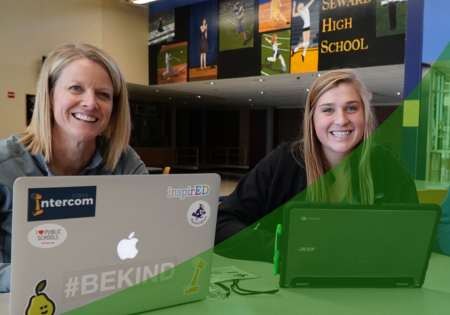In 2017, managing my school’s social media accounts as a high school administrator quickly became a part-time job on top of my already full-time duties, and I knew I needed to find another way to maintain the information train for which our school patrons were clamoring. During a late-night perusal on Twitter, I ran across a product called Class Intercom that was created by Nebraska entrepreneurs, and a few tweets later, I had a working relationship with one of the founders.
As I continued to learn more about this product, my tenure as an assistant principal also meant I was experiencing some dealings with negative social media issues; however, I wanted to approach the issue proactively and positively. The path I chose to take was to empower students to use social media in a positive way to seek and share information, collaborate, and strengthen their social empathy and awareness. Teaching students to create content for someone or something other than themselves for an authentic audience would help them not only learn digital citizenship but also apply the concepts to their own digital footprint, right?
In the fall of 2018, I initiated my first social media intern, a senior girl who was active on Snapchat, as indicated by the continuous use of her phone during her lunch period. This one student quickly grew into a team of 25 student volunteers who in short order took over the brunt of my social media posting duties. At the end of the year, I gave them a survey and the pertinent theme running throughout was the belief that being a part of this team had greatly influenced their personal social media use: they thought before they posted, cared about accuracy, considered how others might misinterpret their posts, and began to cultivate the notion of a personal brand.
These experiences can be summarized in three simple, yet impactful lessons:
Share Your Story
Somebody is going to tell your school’s story. If you don’t tell it, somebody else will tell it for you. Creating a digital footprint and modeling positive digital citizenship will serve your district in multiple ways including brand recognition, school marketing, and the spread of positive culture. With increased mobility of students as well as open enrollment opportunities, competition for students continues to increase. Telling your story is not only important for the students currently enrolled in your school but also for those who may want to join you.
Trust Your People
Whether your social media content is led by staff or students or a combination of both, providing your team with a wide range of opportunities to create content increases involvement, spreads the workload, and creates a more authentic voice for your school. Trust is an essential element in the empowerment of others. Giving up control may be difficult, but Class Intercom mitigates the risk of extending that trust.
Build Your Capacity
The more you do, the more your stakeholders will expect. This is a good thing, but building capacity by empowering others is the key to long term success. My mom used to reference the proverb many hands make light work; this work may include creating graphics, generating posts at live events, writing scripts, or wielding a camera. The more people you empower to create content also means the opportunity for more errors to occur and more corrective feedback to be provided by stakeholders; conversely, the positive accolades received will far outweigh the negatives including thank you notes from grandparents in other states, emails from parents in split households living in two communities, offers of financial support, and gracious posts on the school social media sites.
If the 2020-21 school year taught me anything, it is the need for us to stay connected in innovative ways no matter where we are or what we are doing. I am honored to help you explore the best way to share your story and stay connected with those who care about our number one commodity: the students.
